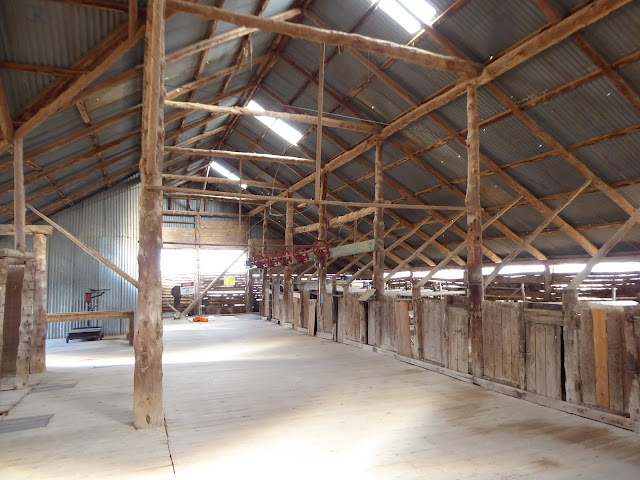It had not rained for over a day, so we decided to chance the roads to Mungo National Park.
It takes a bit to get there - you are on bitumen as you cross the river and head out the Silver City Highway, then turn off on Arumpo road, but this doesn't last too long and the last 80km or so is on dirt road of varying conditions. This road gets closed in wet weather due to the danger of driving on it and also the risk to the road surface itself.
 |
| How to head towards Mungo National Park from Mildura |
 |
| The location of Mungo National Park |
 |
| The artist Russell Drysdale painted the famous "Walls of China" painting in 1945 which is still in the NSW Art Gallery |
Zanci Station was next door (owned by the Vigars) and now also part of the park, along with some other neighbouring stations.
The impressive old shearing shed (made of the native pine) remains and has been somewhat restored, along with underground tanks and ruins around the place. There were 18 stands in the shearing shed at one time.
Lake Mungo is one of the lakes in the Willandra Lakes region but has been dry for many thousands of years.(around 20,000). It was home to the native people when it had water and is still considered home by three different groups who share management input.
As Sediments from up to 100,000 years ago were eroded by the wind the land gave up its secrets to the scientists in the 1970s and Mungo Lady (in her 20s when she died) was found to have been burnt after death (thought to be the earliest cremation) while Mungo Man (in his 50s) was painted with Ochre (also a burial rite it is thought) prior to burial. Both skeletons have been dated around 42000 years ago. This dates humans exhibiting social rites so long ago that it is highly significant.
There is a loop drive that you can take (70km)
 |
| Loop drive shown in orange |
and there are now boardwalks to walk on to see the Walls of China (hills with eroded mounds) at the Walls Lookout. The Walls of China are basically an area on the moon-shaped (Lunette) eastern side of the lake 38km long where the sand was blown to , and then eroded into strange mounds. You can see the varying colours from the various times of deposition.
 |
| The red colour comes from 100,00- 120,000 years ago, the grey is from 50,000 to 25,000 years ago and the paler brown is from 25,000 to 15,000 years ago. |
Further along the drive you come to another boardwalk (At Red Top Lookout) where you can get up close to the erosion and see how it looks.
The formations really are quite extraordinary!! You do get a feeling that history has happened here.
Further along the drive we stopped at Rosewood Rest (among a stand of Rosewood trees on a red sand hill) to have a very late lunch
 |
| mallee |
 |
| This particular mallee has bright orange/ red buds - very noticeable right at the moment. |
We came past the ruins of the old shepherd's hut (originally dragged here on a sled from the main station) - now just a pile of wood and metal among rabbit warrens and wandering emus on the exposed plains.
and later arrived at a dam (Round Tank) where a goat trap used to be set up and used. The remnants of the goat trap remain and were interesting. The ramp (below) was for the feral goats to go up. They would then jump over the end to get to the water (dry dam at the moment) . The fence was high enough to keep them by the dam until they were rounded up into the yards and up the ramp (second photo below) to be taken away for culling, and thus removed from the park. The whole thing is currently in disrepair, with a higher fence further out around the dam.
Further around the loop we came to the old Zanci Station homestead site - still with old chimney, underground covered tank and old dugout where the owners used to take refuge when it was really hot.
 |
| Zanci station was annexed into the Park in 1984. You can still see the old border fence as you cross it. |
 |
| The old underground dugout. Refuge from searing heat. |
A final view over the dry lake as we left the park gave us the opportunity to take in the enormity of this amazing scene.
On our rather rushed trip back to Mildura we were treated to a great sunset over the vast Aussie plains.













No comments:
Post a Comment